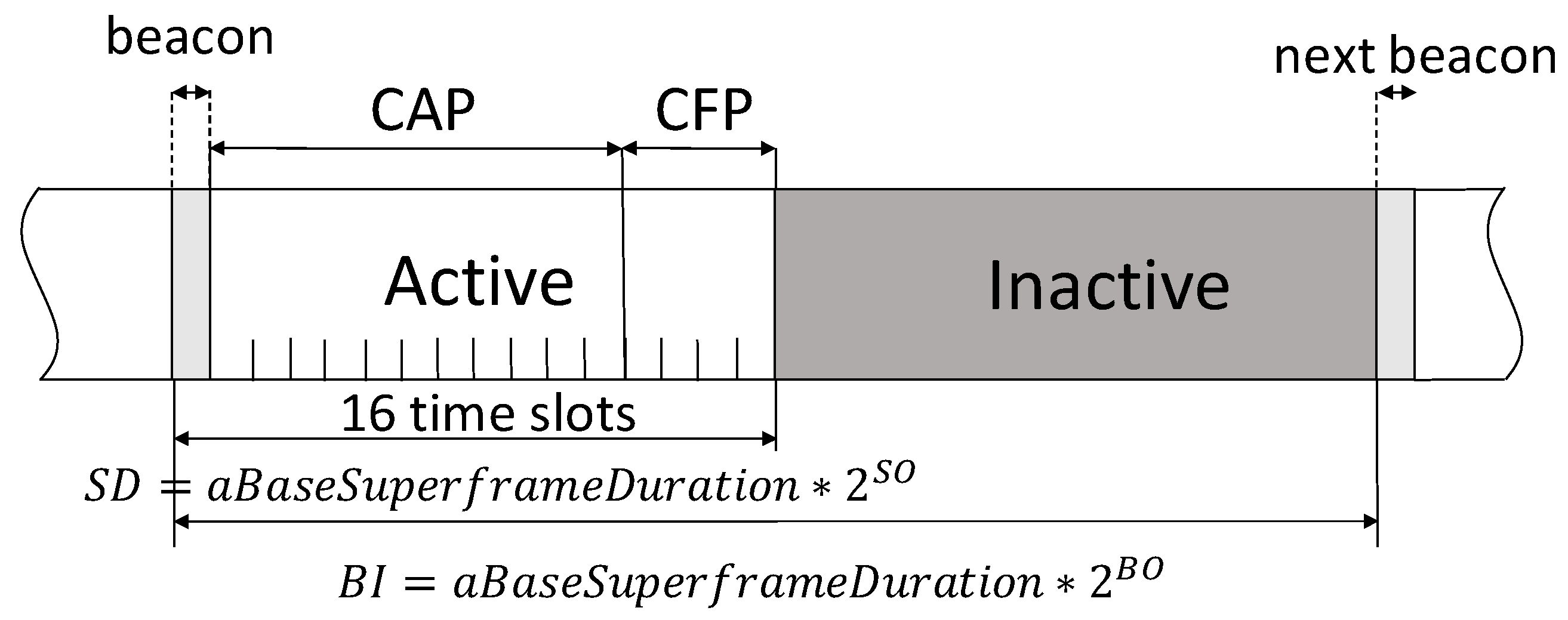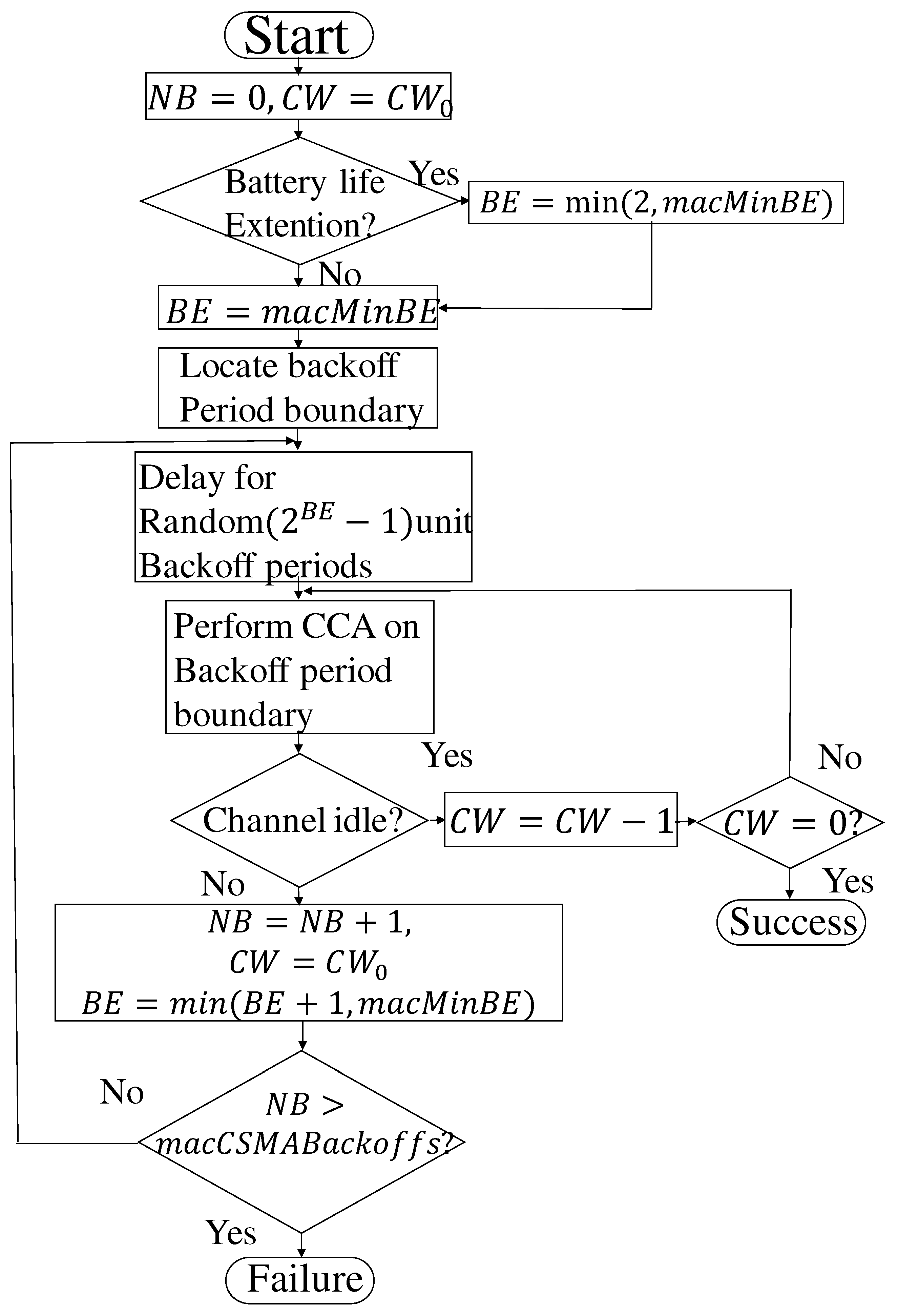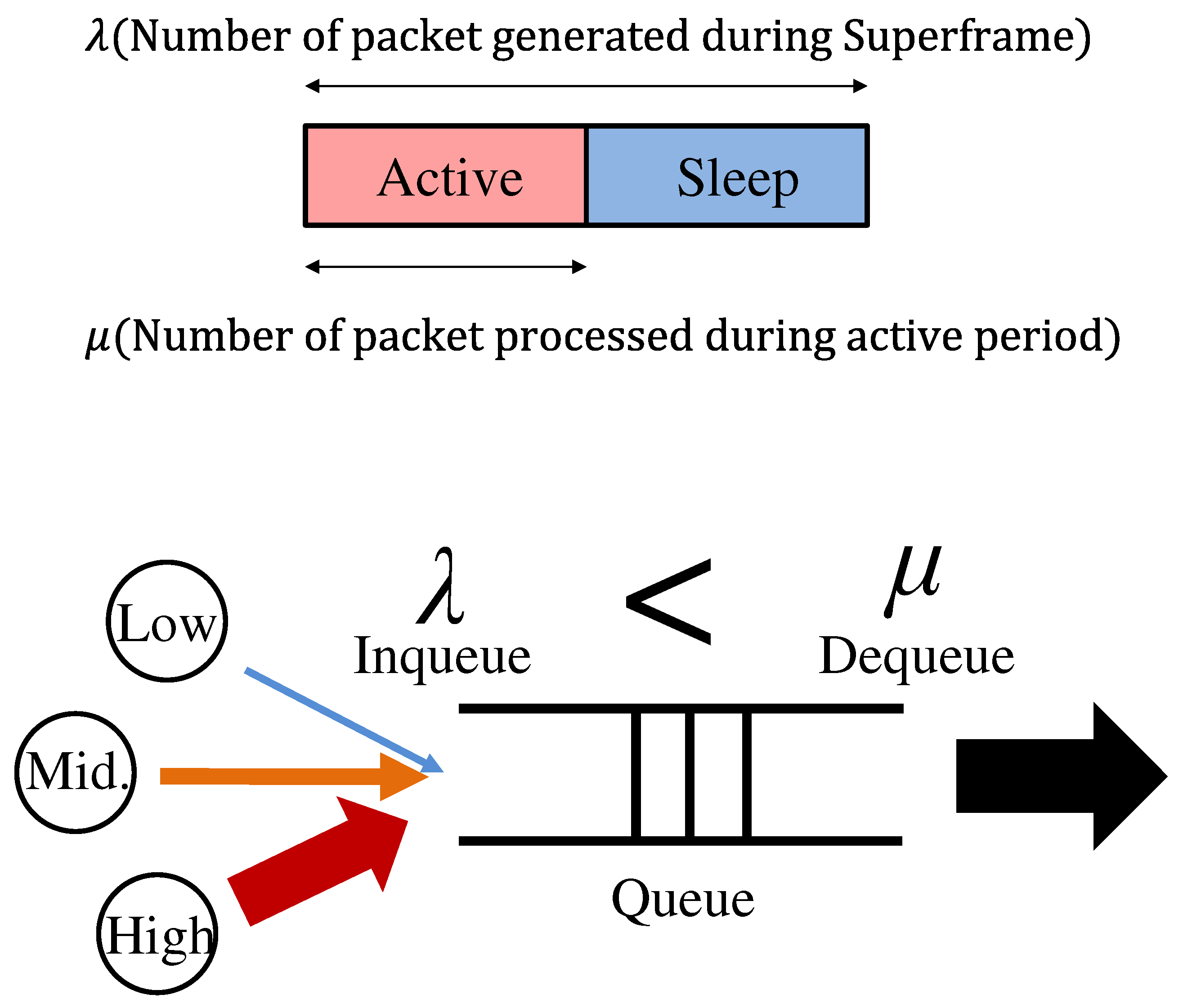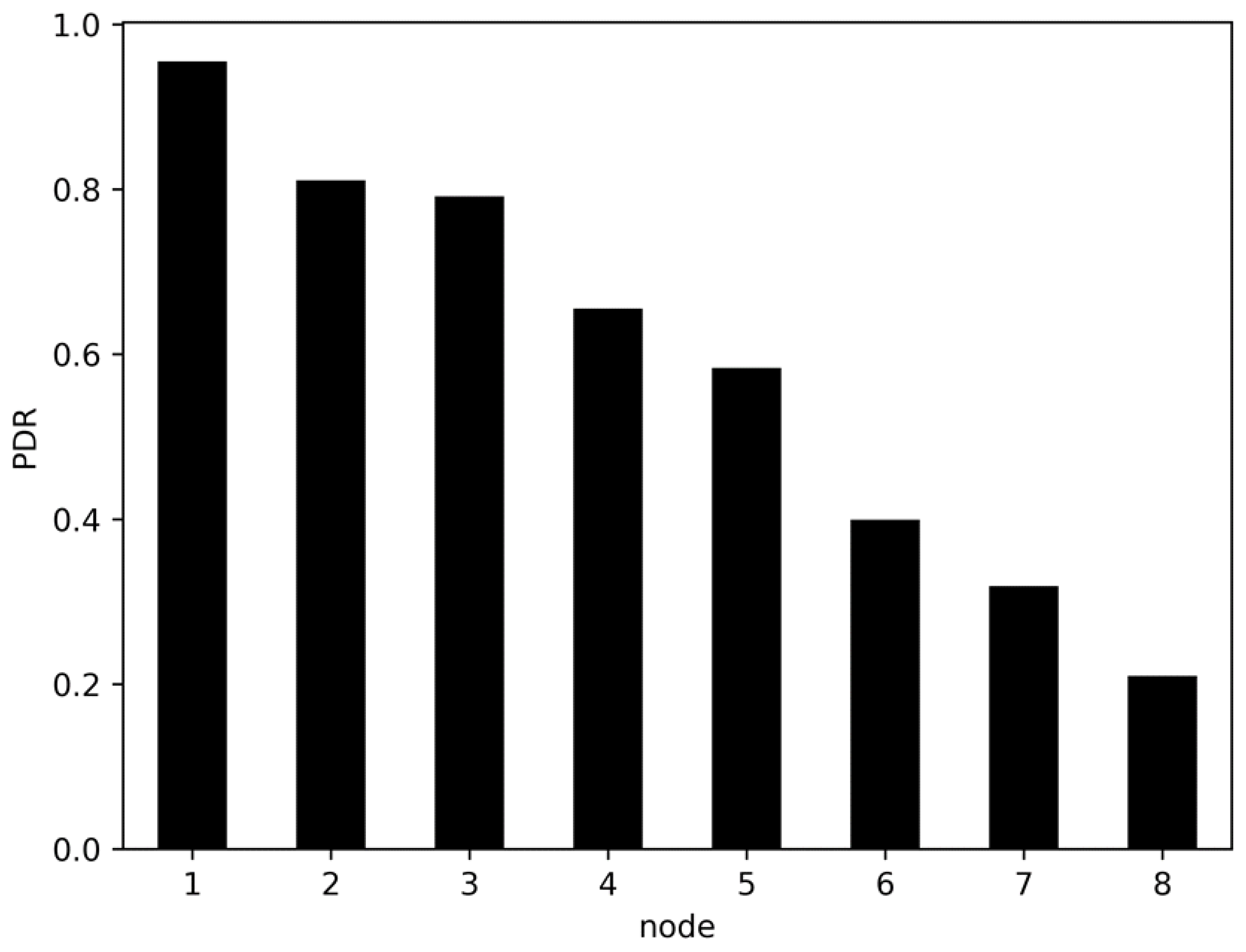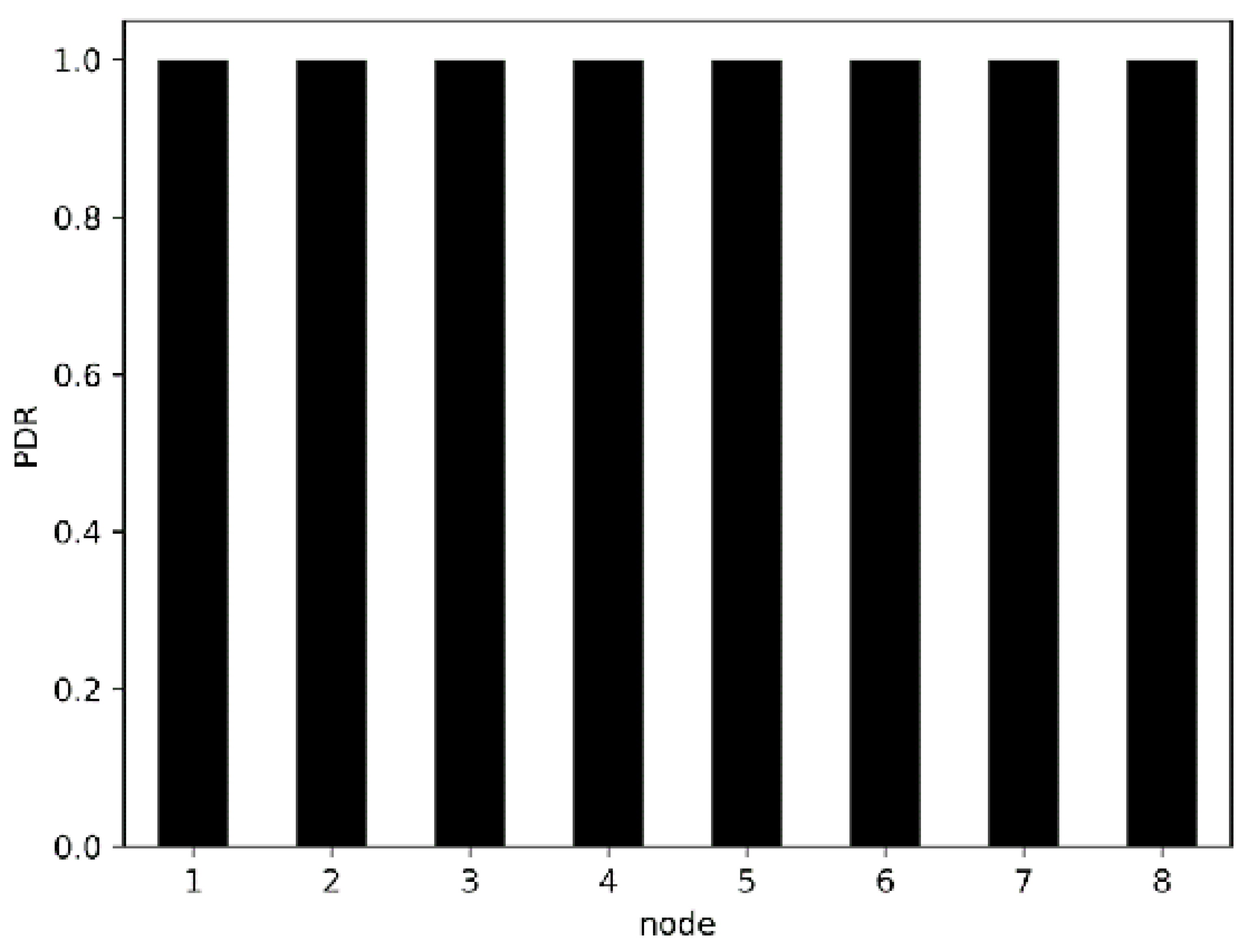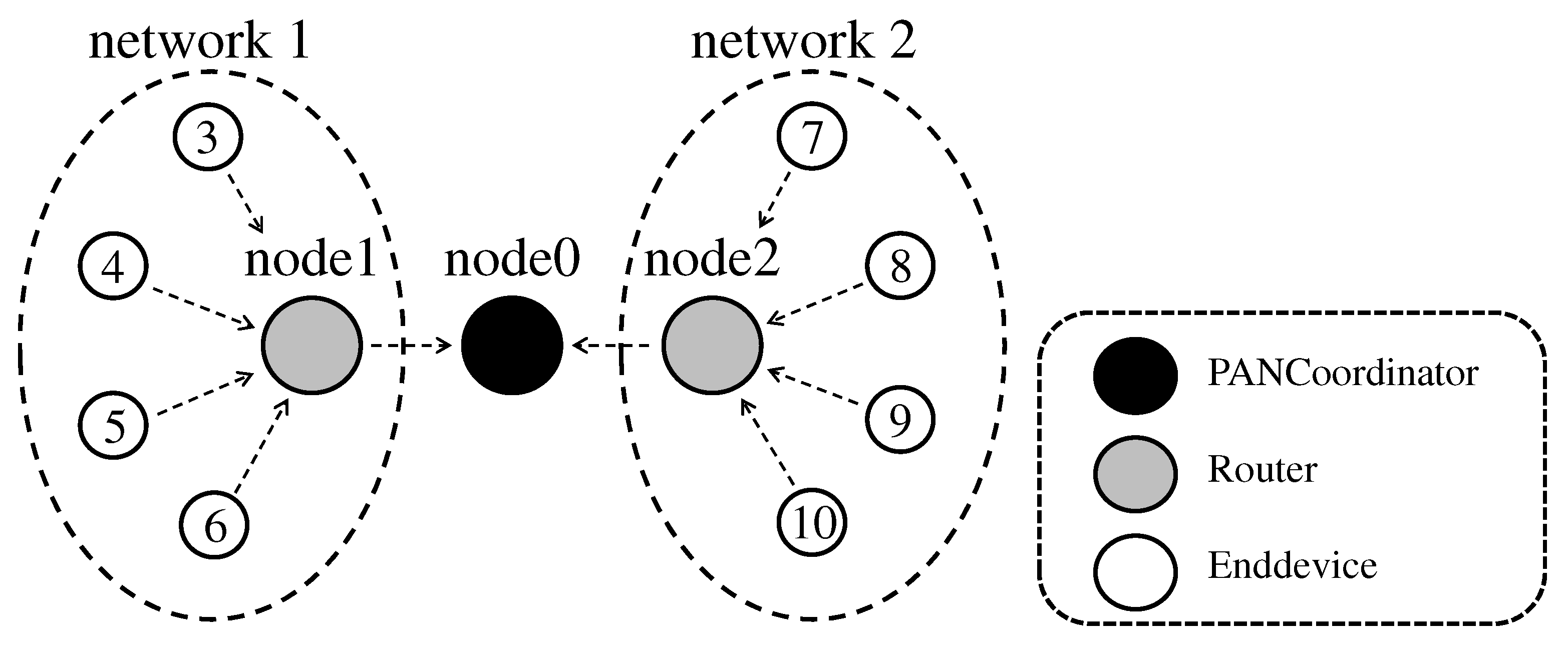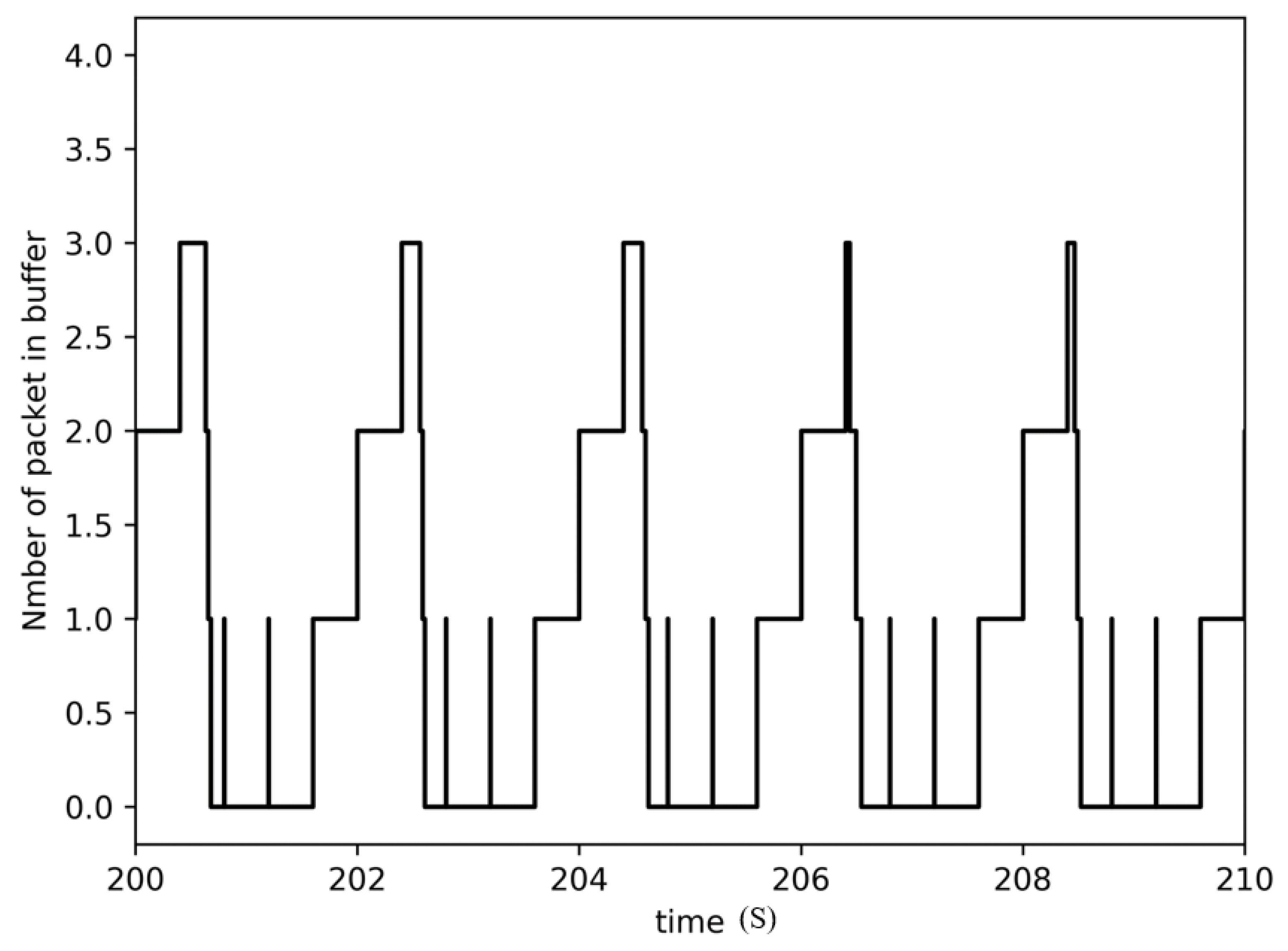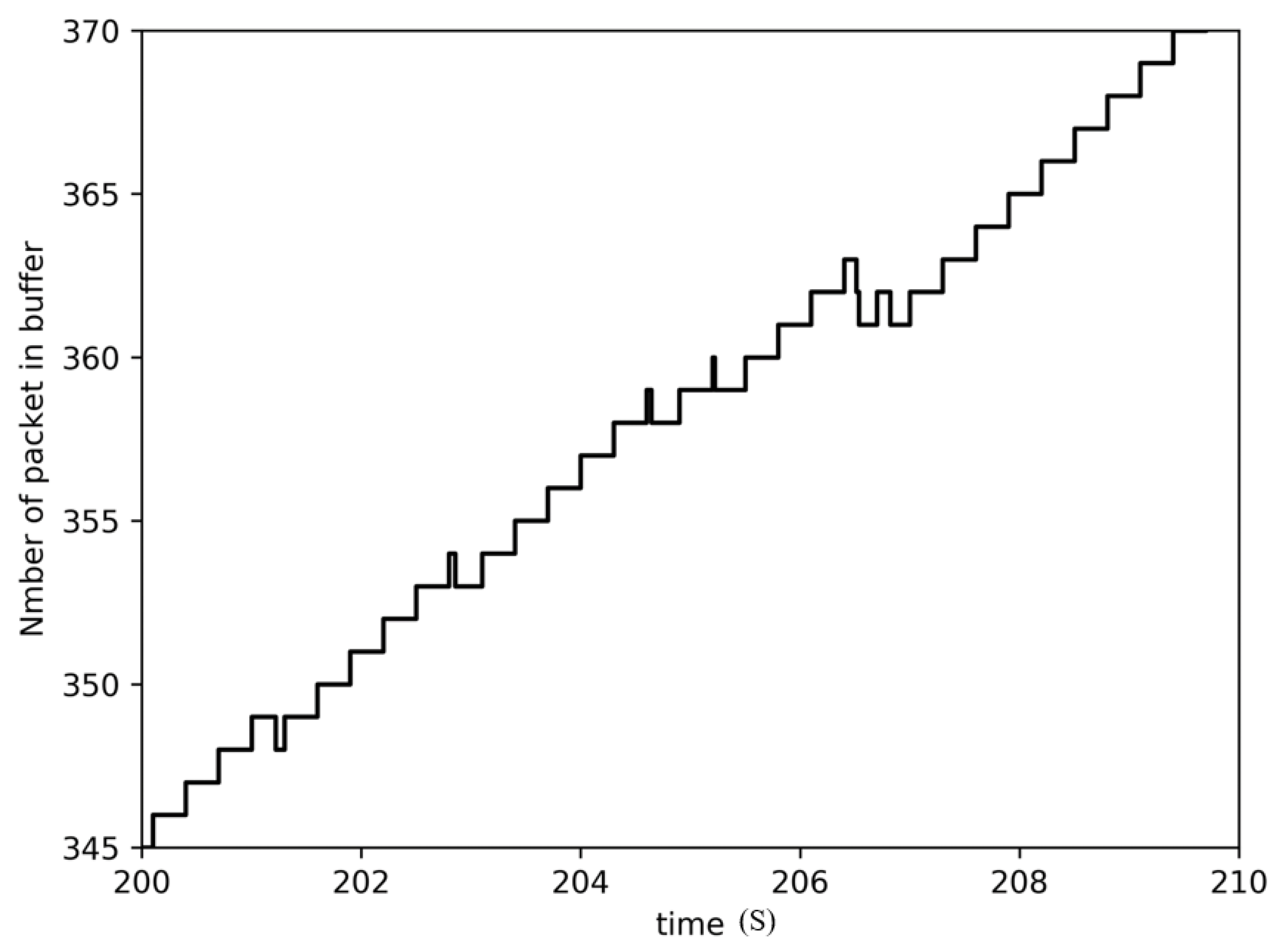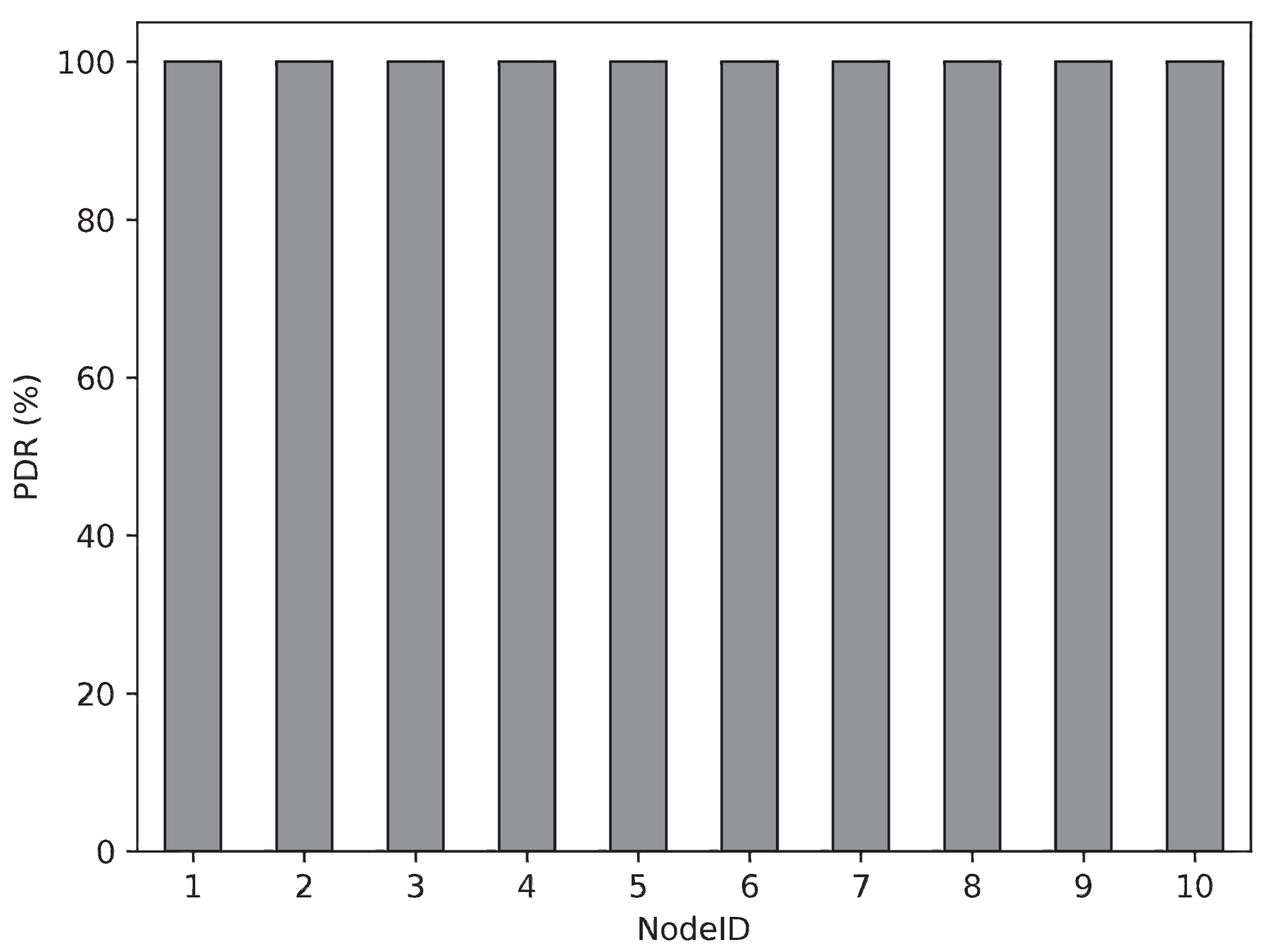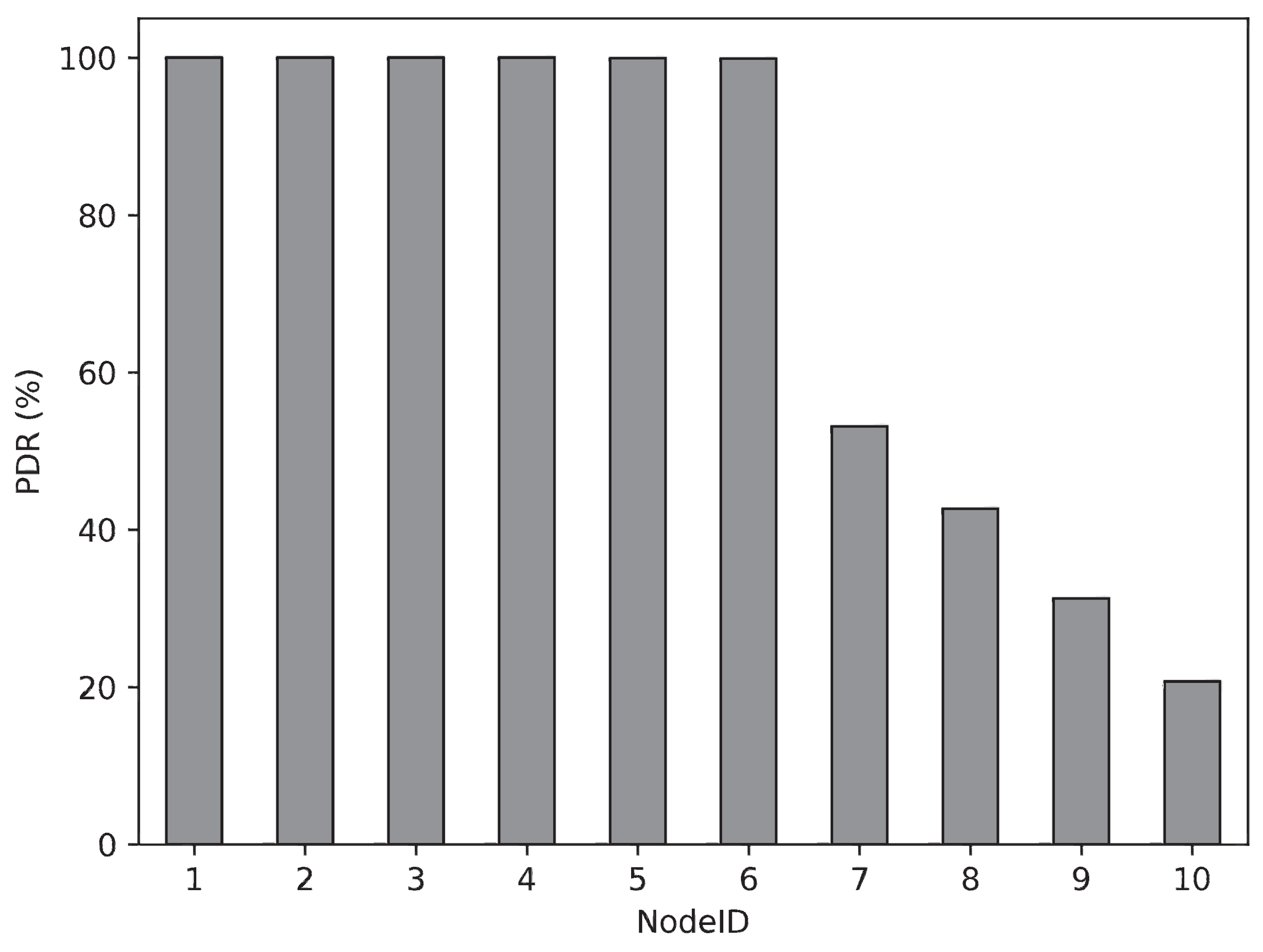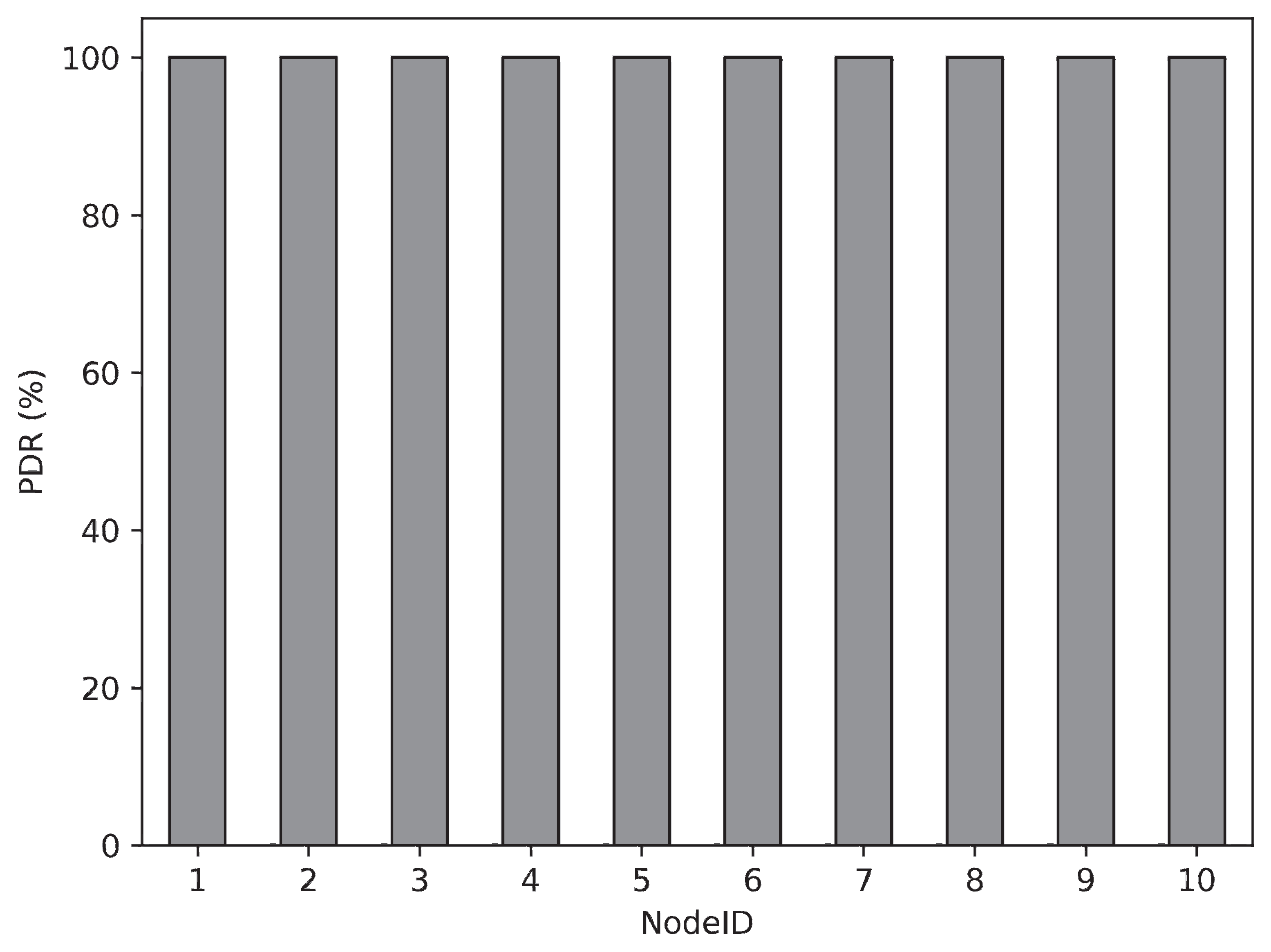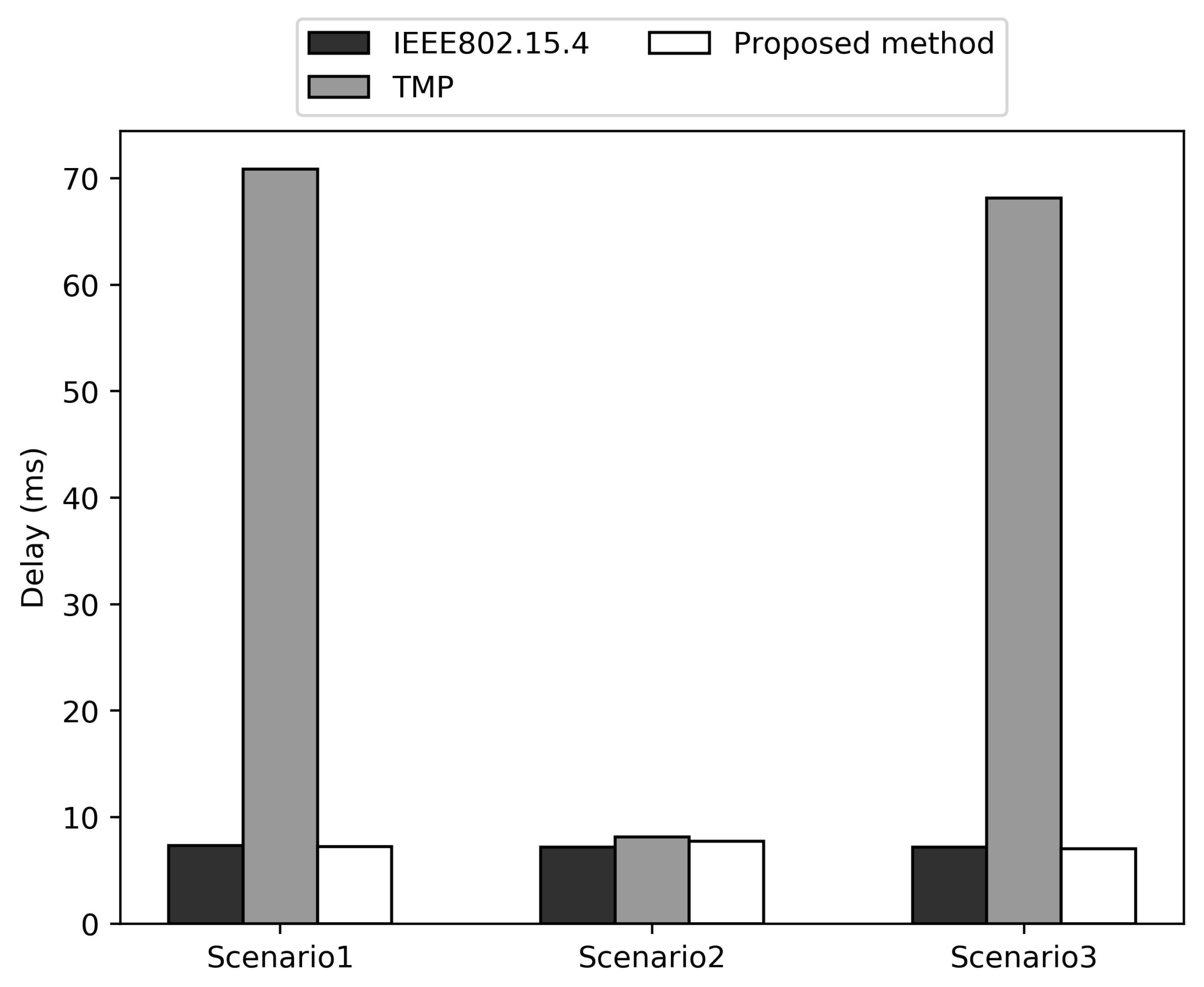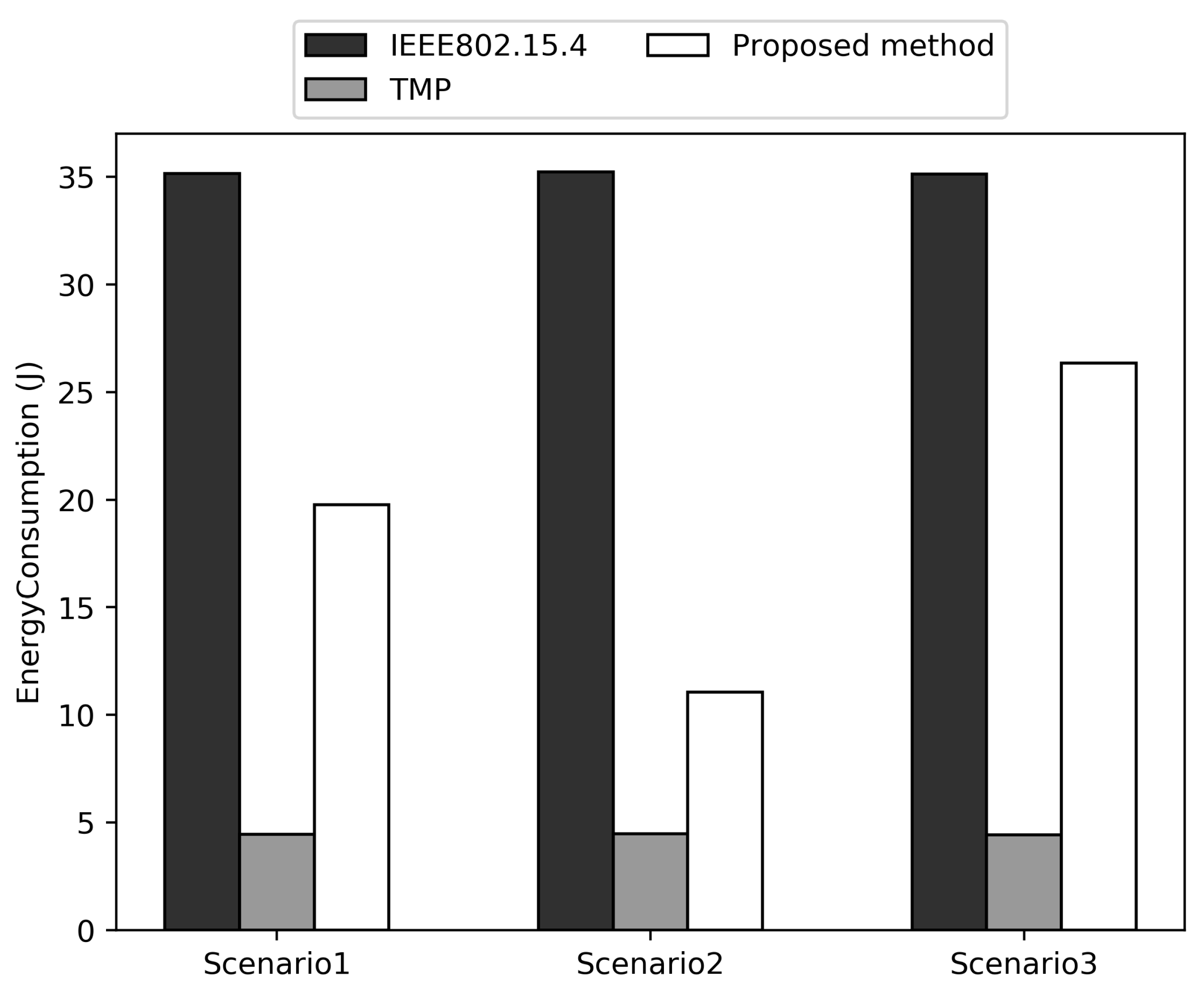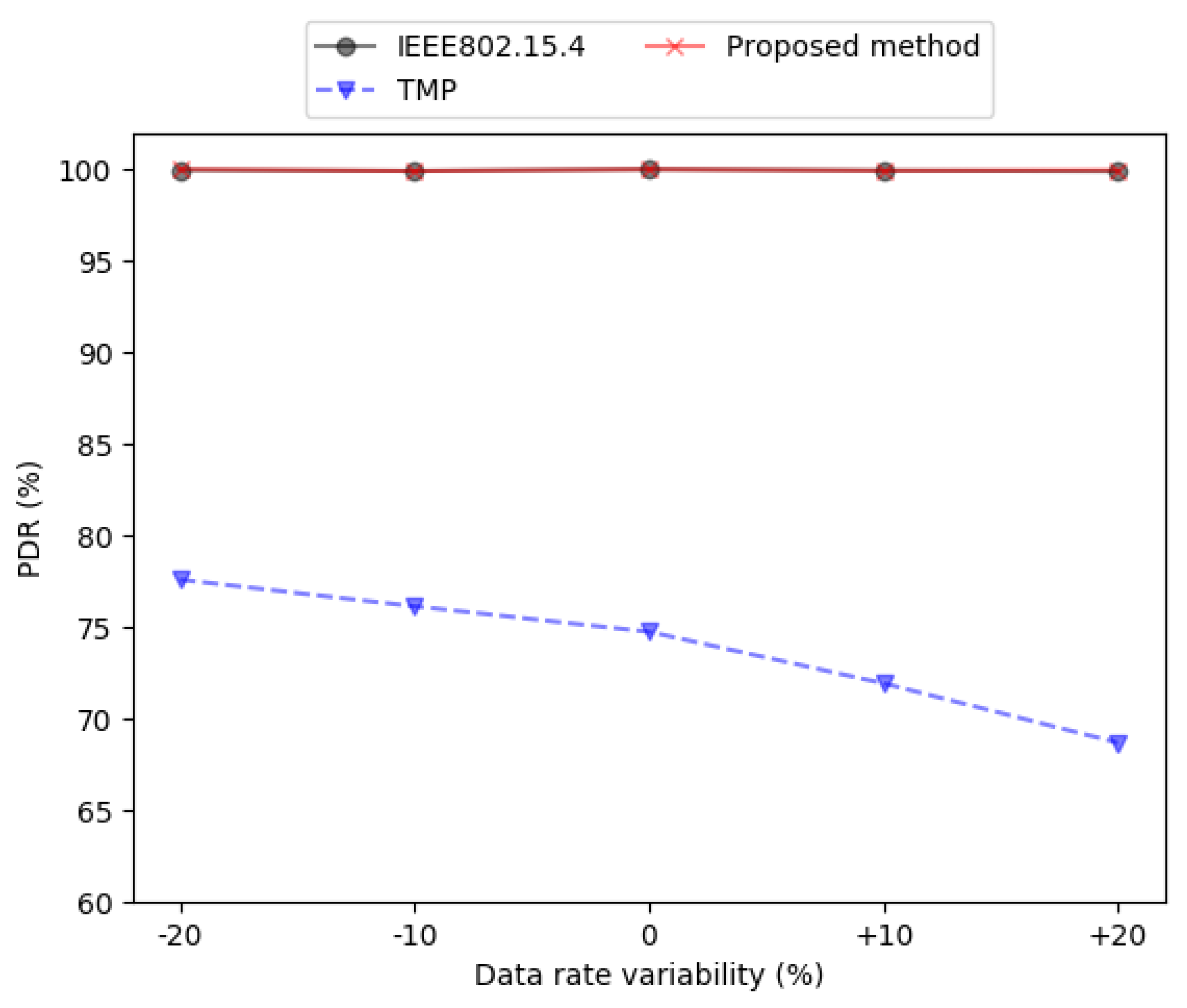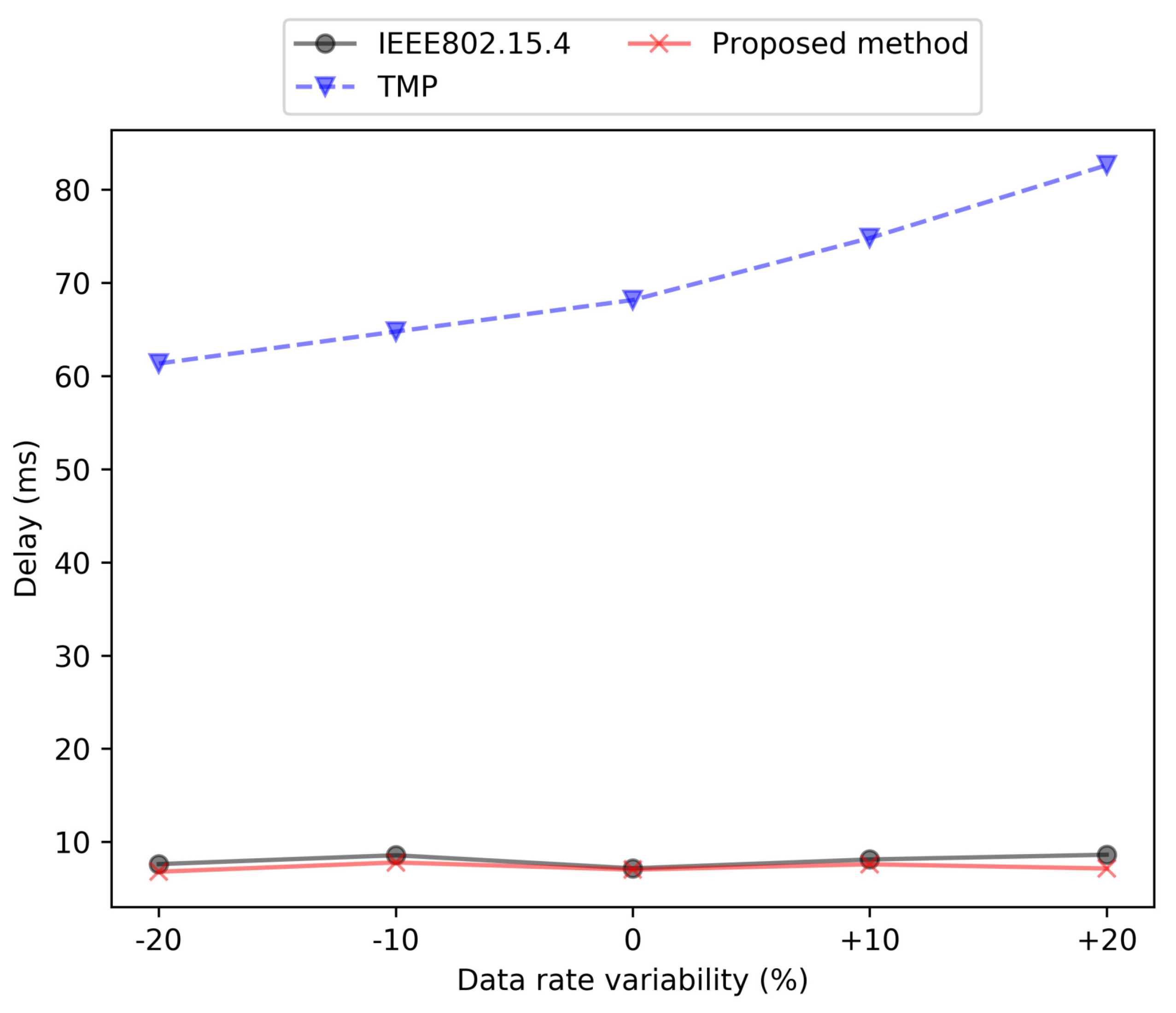1. Introduction
Ad-hoc sensor networks have been paid attention in various applications, such as environment monitoring and smart home [
1,
2,
3,
4,
5,
6,
7,
8,
9,
10,
11,
12,
13,
14,
15,
16]. Today, heterogeneous Wireless Sensor Networks (WSNs) also gain enormous attention due to the diversification of applications, such as medical applications and environmental monitoring systems [
17,
18]. In heterogeneous WSNs, various components are heterogeneous, such as sensor nodes’ traffic sources (low/middle/high) and network topology (star/tree). Therefore, it is difficult to control heterogeneous WSNs nodes’ operations because of their complexities.
The IEEE 802.15.4 is the standard of WSN. The devices communicate with superframe structure in the IEEE 802.15.4 standard [
19]. In the superframe structure, the communication of each node is managed by the active and sleep cycles (Duty-Cycle). The energy consumption of WSN nodes are saved by controlling DC. The Quality of Service (QoS), such as Packet Delivery Ratio (PDR) and delay, is controlled by tuning the MAC (Medium Access Control) parameters [
18,
20,
21,
22].
Z. Xiao et al. proposed a scheduling protocol for star topology WSNs [
20]. The protocol proposed in Reference [
20] controls active and sleep periods taking into account the buffer occupancy of sensor nodes. However, the protocol proposed in Reference [
20] is not suitable for controlling heterogeneous WSNs nodes’ operations since it is proposed under the assumption of the homogeneous networks.
A. Karalis et al. proposed a beacon signal avoidance protocol for homogeneous tree topology WSNs in order to achieve high PDR and low energy consumption [
22]. Although the collision avoidance protocol proposed in Reference [
22] can avoid beacon signal collisions, it does not guarantee collision avoidance of outgoing packets of sensor nodes.
The Tele-Medicine Protocol (TMP) [
18] is an IEEE 802.15.4-based MAC protocol for heterogeneous WSNs. The TMP tunes DC and MAC layer parameters to meet the QoS requirements in the medical field. The TMP controls the active-period length of a superframe to be shorter in order to reduce energy consumption. However, for high data rate nodes, the shorter the active period, the more packets are lost, and the lower the PDR [
23,
24,
25,
26].
This paper proposes a duty-cycle control method in order to improve the PDR for IEEE 802.15.4-compliant heterogeneous WSNs. The proposed method tunes the DC so that the buffer occupancy of sensor nodes is less than one and assigns DC to each sub-network (sub-network means a network consisting of a router node and its subordinate nodes). The appropriate DC of each sub-network can be used to obtain the high PDR; thus, this paper gives analytical expressions of the buffer occupancy. The proposed method can control DC heterogeneous star and/or tree-topology wireless sensor networks. Simulation results show the effectiveness of the proposed method.
3. Proposed Method
This paper proposes a DC control method to achieve high PDR for IEEE 802.15.4-compliant heterogeneous star and/or tree topology WSNs.
Figure 3 shows the example of a tree topology heterogeneous WSNs. In homogeneous WSN, communication qualities, such as PDR and energy consumption, can be improved by setting the same DC for all sensor nodes. On the other hand, in heterogeneous WSNs where data rates of sensor nodes are different, even if the same DC control is applied to all sensor nodes, the high communication quality may not be achieved because of the different characteristics of the network nodes. In order to solve this problem, the proposed method allocates an appropriate DC for each sub-network (sub-network means a network consisting of a router node and its subordinate nodes). DC is controlled in consideration of the buffer occupancy of nodes.
This paper assumes that each router node does not generate its own packet. In this section, we also assume that there are no transmission failures. Each router node generates a packet when relaying packets from the end devices. We assume that the number of generating packets of router node
i in one superframe duration
is given by
where
is the total data rate of end devices which belong to router node
i, and
P is a packet payload size (byte).
Assuming that there are no transmission failures, the data rate of router node
i is given by
where
is the number of end devices which belong to router node
i. Assuming that router node
i transmits
packets during
, the total number of transmitted packets during one active period, which indicates the service rate of node
i,
, is
Assuming no contention,
is given by
where
is given by Equation (
8), and expressed as
where
is the maximum number of carrier sensing trials,
and
are time to backoff and carrier sense, respectively.
expresses the time to transmit a packet. When the data transfer speed is 250 (Kbps),
In Equation (
8),
is the time to transmit an ACK frame,
is short inter frame space, and
is the waiting time for the next transmission.
From Equations (
4) and (
6), the buffer occupancy of router node
i is expressed as the ratio of the number of generating packets of router node
i in one superframe duration,
, to the service rate of node
i,
.
is given by
For avoiding buffer overflow, DC should be controlled so that
is less than 1, as shown in
Figure 4. From Equations (
4)–(
10), DC should satisfy:
4. Simulation Results
The proposed method is evaluated by Network Simulator 2 (NS2) [
27].
Table 1 shows the simulation parameters. Simulation is conducted by using a frequency band of 2.4 GHz. In this simulation, the energy consumption parameters of CC2420 [
28] are used; Tx energy is 31.25 mW, Rx energy is 35.28 mW, Idle energy is 0.712 mW, and Sleep energy is 0.144 mW. In addition, this paper uses IEEE 802.15.4 default MAC parameters [
19].
This study assumes that the packet transmissions are failed due to collisions caused by concurrent transmissions.
This study does not assume transmission failures due to physical layer conditions.
4.1. Star Topology WSN
Figure 5 and
Figure 6 show the PDRs of the TMP method [
18] and the proposed method in the star topology WSN, respectively. The data rate of each node is shown in
Table 2. In the TMP method, the PDR of end devices decrease as the number of nodes increases. This is because the TMP method does not adequately control DC for high data rate nodes. On the other hand, in the proposed method, the PDR of end devices do not decrease so much. It is seen from this result that the proposed method can cope with the increase in the data rate.
4.2. Tree Topology WSNs
Figure 7 shows the tree topology WSNs used in this simulation. Nodes 1 and 2 are route nodes. Networks 1 and 2 are composed of router node 1 and its end devices and router node 2 and its end devices, respectively. Each router node does not generate its own packet. Each router node generates a packet when relaying packets from the end devices. This study compares the proposed method, the DC control method considering buffer occupancy for 802.15.4-compliant homogeneous WSN, and the TMP method. We evaluate the proposed method under three scenarios.
Table 3 shows the DC for each method. The proposed method uses three DC patterns since the proposed method tunes the DC according to the data rate of the subordinate nodes.
Table 4 shows data rate of each node. In these tables,
and
are DC and data rate of router node
i, respectively.
4.2.1. PDR Evaluation
Figure 8 and
Figure 9 show the number of packets in the buffer of a sensor node with and without appropriate DC control, respectively. In
Figure 9, the number of packets in the buffer increases in time. On the other hand, in
Figure 8, the number of packets in the buffer does not increase because the generated packets are processed in the active period. It is seen from
Figure 8 and
Figure 9 that the appropriate DC control can avoid packet accumulation in buffer.
Figure 10,
Figure 11 and
Figure 12 show the PDRs of the IEEE 802.15.4, TMP, and proposed method in scenario 3. The IEEE 802.15.4 and proposed method achieve high PDR. On the other hand, as the data rate of the node increases, the PDR of the TMP decreases. The TMP method has a lower PDR, although it achieves low energy consumption.
4.2.2. Delay Evaluation
Figure 13 shows the average delay of each scenario and each method. In this study, the delay is defined as the time from the focused packet transmission to arrival at the coordinator. The lower the delivery ratio becomes, the more packet retransmission occurs. If the focused packet is not successfully transmitted within the active period, the packet is newly transmitted at the next superframe, which causes extreme delay. In Scenarios 1 and 3, the delay of TMP increases due to the decrease in PDR.
4.2.3. Energy Consumption Evaluation
Figure 14 shows the energy consumption of whole network nodes. The TMP uses low DC, so energy consumption is low. Since IEEE 802.15.4 sets DC regardless of the data rate of the nodes, it wastes the energy by idle listening. The proposed method reduces idle listening by setting appropriate DC for each sub-network while guaranteeing PDR.
4.2.4. Sensitivity Analysis
Figure 15,
Figure 16 and
Figure 17 shows the sensitivity analysis of the PDR, delay, and energy consumption in scenario 3. The horizontal axis of each graph is the variation of the data rate in the range of
% to
%. From
Figure 15,
Figure 16 and
Figure 17, the TMP is sensitive to data rate variations regarding PDR and delay, and proposed method is sensitive to data rate variations regarding delay. In addition, these figures illustrate that the variations in data rate do not affect the order of performances.
4.3. Summary of Results
Table 5 summarizes the simulation results of the PDR, delay, and energy consumption of each method.
Table 6,
Table 7 and
Table 8 show the evaluation criteria for each of Good, Average, and Bad in
Table 5.
Table 5 illustrates that the proposed method achieves a reasonable delay and energy consumption while maintaining high PDR.
